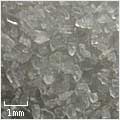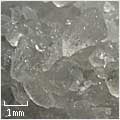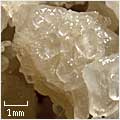
“I need to learn how to season.” Those were her exact words. No one had ever said that to me before. Usually people want to learn how to prepare a particular dish, usually just like their mother used to make it or the same as they ate ten years ago in Paris. But she was the first to say that she needed to learn how to season. It was certainly a reasonable request.
What does it mean “to season”? It is not the application of herbs and spices to food. Seasoning is simply the addition of salt. A simple dish of haricot verts (French green beans) boiled without salt can taste flat, but with the addition of the right amount of salt to the cooking water, the beans come to life. Bread made without salt has the taste of cardboard, but prepared with a little salt it has a more rounded flavor. A slice of fresh tomato lightly salted will taste sweeter, not salty. Even sweet dishes often benefit from the addition of a little salt.
As Paul Bocuse, possibly France’s most famous chef of the last half of the twentieth century, wrote:
Assaisonner, action de saler à point ; action simple et cependant capitale pour la cuisine qui exige du sens, le « goût », une grande subtilité, doublée de beaucoup d’attention et de discernement.1
(Seasoning is adding the correct amount of salt—a simple act that is most important in cooking; it requires great subtlety from the taste buds, and much attention and discernment.)2
There are some who would claim that adding salt is not a simple act, but is actually an act of “applied ignorance,” since most recipes instruct the cook to salt “to taste” and say the proper amount “cannot be precisely defined.”3 My experience working in a number of restaurant kitchens in France is that the chefs commonly complain that the young cooks working below them never salt food sufficiently. (Of course I’ve never seen them attempt to train these cooks how to salt, only complain about how they do not know how!) I would, however, contend that seasoning is easy to learn if one understands how salt interacts with food and taste.
Salt is generally added as a seasoning to food in France, as elsewhere, not to give it a salty flavor but to enhance the flavor of the principal ingredients. The amount of salt required to provide this enhancement is not a fixed ratio of salt to principal ingredient. A little may have no effect. A little more may start to liven up the taste. Adding still a little bit more salt may provide a little more enhancement. A further addition may make no additional improvement. At some level, if still more is added, the dish will begin to taste salty. As illustrated below, there is a range of how much salt is added to provide for a “properly seasoned” dish; there is not just one right amount.

Note that many foods that actually taste salty have not been seasoned with salt for flavor but for preservation. This is most commonly seen in meat or fish that has been preserved with salt, either in a dry form as crystals or a wet form as a brine. Two previous articles on this web site, saumon non cuit and poitrine de porc, provide numerous examples of using salt in this manner.
Getting back to using salt simply to affect the taste of food, in 1997 Breslin and Beauchamp reported salt enhanced flavor by suppressing the natural bitterness of the underlying ingredients.4 This may seem a bit odd as you sprinkle a bit of salt on your morning cantaloupe, but if you taste the plain fruit carefully, you may notice some bitter taste along with the sweet. Try it also with an avocado. The effect for you here may be a bit more noticeable.
Usually when we season our food with salt, the crystals of salt have sufficient time to dissolve into the food and we don’t taste the individual salt crystals. There are times though when salt is added at the point of service so the taste of the salt crystals is distinguishable from the underlying food. In this case, the salt is actually being used more as a condiment than a seasoning.
But getting back to the original question, how do you season? How much salt should be added? Early French cookbook writers tended to ignore this question altogether. François Massialot5 and François Pierre de la Varenne6 usually only say to assaisonner avec du sel (season with salt), if they mention seasoning at all, which they usually do not. These authors were writing for a professional audience and it was assumed that other professionals would know how much salt to use and when to use it. Looking through a sampling of French cookery books written from the beginning of the 14th century until the middle of the 19th, I was unable to find a single, precise quantity given for seasoning with salt. Jean Anthelme Brillat-Savarin has fifteen references to salt in his book.7 About half are instructions to use salt for seasoning, but the quantity is never specified. Dubois and Bernard, writing what may be the first great cooking tome dedicated to le service à la russe albeit on a royal level, rarely even mention salt.8 Occasionally they mention assaisonnez (to season) and even less frequently will list salt as an ingredient if they happen to delineate an ingredient list separate from the body of the recipe.
In 1867, Jules Gouffé wrote what may be the first French cookbook with a section devoted to home cooking.9 As he states in the book’s preface: “I have divided the book into two quite distinct Parts,—the First, treating of Domestic Cookery, the Second of the Higher Class Cookery.” Gouffé is very specific about how much salt to use.
The expressions pinch and small pinch of salt and pepper will, at every moment, recur to convey a notion of determined quantities, which it is important to specify accurately, if one is to proceed with certainty. The scales are of course the best criterion of quantities ; they are of frequent assistance, but, in the hurry of work, to have continual recourse to them is impracticable.
It will, therefore, be necessary for everyone to ascertain the capacity of one’s fingers by weighing what they can hold ; thus it will be found that, in taking a pinch of salt or pepper, such or such definite weight is taken.
I have adopted 1/4 oz. as the weight of a pinch [and] 1/16 oz as that of a small pinch. Whenever I shall have in the text to use the words pinch and small pinch, an exact idea will thus be had of their equivalent weight.11
On emploie à tout instant, en cuisine, les termes de pincées, de prises de sel et de poivre, pour spécifier des quantités déterminées et qu’il est important de fixer d’une façon positive, si l’on veut opérer avec certitude.
La balance est sans doute le meilleur moyen d’apprécier au juste les quantitiés ; il est nécessaire souvent d’y avoir recours ; mais, au moment de l’activité de travail, son emploi devient à peu près impracticable.
Chacun devra donc se rendre compte préalablement de la capacité de ses doigts en prenant ce qu’ils peuvent contenir. On saura ainsi qu’en prenant une prise de poivre ou une pincée de sel, on se trouve prendre tel poids de sel ou de poivre.
J’ai adopté, comme mesure de la pincée, 10 grammes ; comme de la prise, 2 grammes. Quand j’aurai à employer, dans l’énoncé des recettes, ces mots prise et pincée, on aura ainsi la mesure exacte de ce qu’ils expriment comme quantité.10
Around the same time, Alexandre Dumas, writing his immense collection of recipes, organized in alphabetical order rather than by course or ingredient, refers to salt over 950 times, but usually only as a mention to season with salt.12 Occasionally, he’ll specify deux pincées de sel (two pinches of salt), or sometimes he’ll write un peu de sel (a little salt). But he never says how much a pinch or a little should be. In one recipe he says ajouter suffisante quantité de sel (add a sufficient quantity of salt), but never says how to determine what is sufficient.
A half century later, Henri Babinski again includes specific quantities of salt in his recipes with ingredient lists.13 He even specifies the ratio of salt to water when calling for salted water for blanching.
There were too many French cookbooks published in the 20th century to permit a meaningful survey as to how often the quantity of salt is specified, but my impression from reviewing my small collection is that quantities are rarely given except in recipes for forcemeats and baking. Even books as recent as the 1100-page work by Guy Martin, published in 2003, provide little guidance as to how much salt to use in a recipe.14
Modern sources of French recipes do tend to specify other details about the salt to be used, if not the quantity. Besides just calling for sel (salt), recipes often call for sel fin (fine, white salt), gros sel (coarse, white salt), sel gris (coarse, gray salt containing noticeable trace amounts of magnesium, potassium, and calcium), or fleur de sel (a very white, hand-harvested coarse salt of high purity used as a condiment). Most commercially available salt in France nowadays is harvested from sea water, either from the Atlantic Ocean along the southern coast of Brittany or the Mediterranean Sea just east of Montpellier. In the last decade, there has been a rebirth of artisanal salt production in Brittany15 and high-end chefs will nowadays specify salt by origin.

sel fin

gros sel

sel gris

fleur de sel
But once again getting back to the original question, how do you season? How much salt should be added? As stated earlier, the amount of salt required to properly season a dish is quite variable. Except when making forcemeats for sausage or brines for curing, I usually don’t measure salt by either quantity or weight. I do, however, measure by sight and by taste. When blanching vegetables in salted, boiling water, I add salt to the water before heating it. For this purpose, I use coarse French sea salt and I just shake a goodly amount, about 10 grams per liter, directly out of the salt bowl I keep near the stove.
If I’m salting a dish early in its preparation, I generally use a coarse gray salt since there is sufficient time to allow for the salt pieces to dissolve. When I’m salting a dish to finesse the final flavor, I use fine salt because it dissolves very quickly. If I’m adding salt as a condiment to a dish as it’s being served, I use fleur de sel. I judge how much salt to use with a combination of taste and experience. I add some salt, taste, and if necessary, add some more salt and taste again. As shown in the graph above, the amount of salt required is a range, not a precise amount. So I continue to add salt as the flavor of the dish continues to expand. When the addition of salt seems to make no further improvement, I stop.
The four salts I use sit in small, covered bowls next to my stove. When seasoning, I use three fingers—my thumb, index, and middle finger—to transfer the salt from the bowl to the dish. Only when I need to add a very small amount of fine salt do I use just two fingers.
(Out of curiosity, I measured how much salt I add with my three-finger pinch. A pinch of coarse salt weighed about 4 grams and a pinch of fine salt weighed about 2 grams. Both are much less than Gouffé’s 10-gram pinch. And I thought I had fat fingers!)
Seasoning with salt requires a combination of critical tasting and judgment that comes from experience. It is important for both the new cook and the experienced one to continually taste the food being prepared and to use salt to coax the maximum flavor from it.
The author gratefully thanks Ken Broadhurst of Mareuil-sur-Cher, France, for his superb editing assistance with this article.
1. Paul Bocuse, La cuisine du marché, Paris: Flammarion, 1998. In French. p. 14.
2. Paul Bocuse, Paul Bocuse’s French Cooking, trans. unknown, New York: Pantheon Books, 1977. Originally published as La cuisine de marché. p. xix.
3. See Institute for Applied Ignorance: Applied Ignorance. A Definition.
4. P.A.S. Breslin and G.K. Beauchamp, “Salt enhances flavour by suppressing bitterness,” Nature 387 (1997).
5. François Massialot, Le nouveau cuisinier royal et bourgeois ou cuisine moderne, 3 vols., Paris: Joseph Saugrain, 1748 (vol. I & II) 1750 (vol. III). Originally published as Le cuisinier roïal et bourgeois (Paris: Charles de Sercy) in 1691. In French. Reprint, 2003 by Eibron Classics, divided into 5 volumes.
6. François Pierre de la Varenne, Le cuisinier françois, ou est enseigné la maniere d’apprêter toute sorte de viandes, de faire toute sorte de patisseries, & de confitures (Photocopy of 1680 edition [Lyon: Jacques Canier]) [ebook] (Universitat de Barcelona, 31 Dec 2001 [cited 27 Dec 2003]); In French.
7. Although not a cookbook as such, this collection of essays is often quoted as a standard of its time. Jean Anthelme Brillat-Savarin, The Physiology of Taste or Transcendental Gastronomy. (Originally published in France in 1825 as Physiologie du goût ou méditations de gastronomie transcendante, ouvrage théorique, historique et à l’ordre du jour, dédié aux gastronomes parisiens par un professeur, membre de plusieurs sociétés littéraires et savantes. This work is translated from the last Paris edition, date unknown.) [ebook] (University of Adelaide, 24 July 2002 [cited 27 Dec 2003]). See The physiology of taste, by Brillat Savarin.
8. Urbain Dubois and Émile Bernard, La cuisine classique: études pratiques, raisonnées et démonstratives de l’école française appliquée au service à la russe, 1st ed., Paris: Dubois & Bernard (self-published?), 1864. In French. Reprint, 2003 by Eibron Classics, divided into 2 volumes.
9. Jules Gouffé, Le livre de cuisine, 1st ed., Paris: L. Hachette et Cie, 1867. In French. Reprint, 2003 by Eibron Classics, divided into 2 volumes.
10. Ibid. p. 35.
11. Jules Gouffé, The Royal Cookery Book (Le livre de cuisine), trans. Alphonse Gouffé, 1st ed., London: Sampson Low, Son, and Marston, 1869. Reprint, 2003 by Eibron Classics, divided into 2 volumes. p. 25.
12. Alexandre Dumas, Le grand dictionnaire de cuisine (Originally published 1873 [post.]) [ebook] (Pitbook.com, May 2001 [cited 27 Dec 2003]); In French. See Le grand dictionnaire de cuisine.
13. Ali-Bab [Henri Babinski], Gastronomie pratique: études culinaires, 5th ed., Paris: Flammarion, 1928. In French. Reprint, 1993.
14. Guy Martin, Toute la cuisine, 1127 vols., Paris: Éditions du Seuil, 2003. In French.
15. Mark Kurlansky, Salt: A World History, New York: Walker & Company, 2002. p. 446.

©2004, 2014 Peter Hertzmann. All rights reserved.
